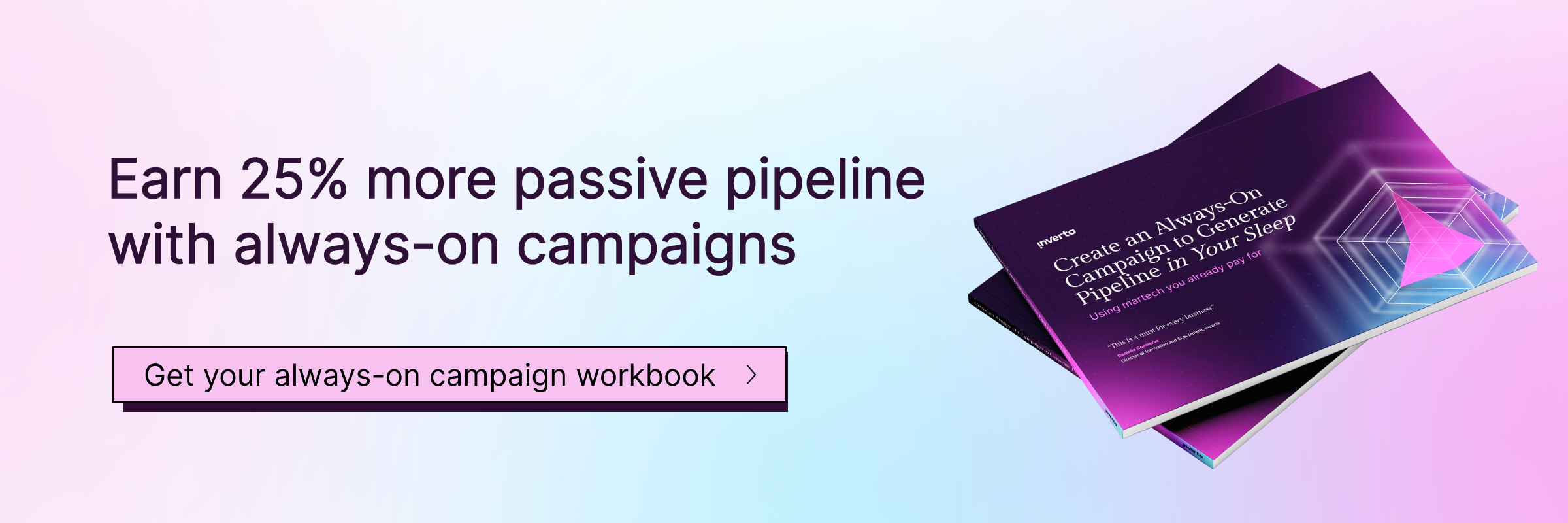Nurtures Don’t Nudge: Rethinking Engagement
.svg)

In partnership with:
Featuring
Featuring
How are you going to stand out in 2026?
Buyers are in control of the buying process. Over 70% of it is happening online. And they are putting companies on their short list of vendors that provide value and establish trust with their content.
How are you accounting for this in your 2026 strategy?
You need to stand out. To make sure your buyers notice you. Let us help you build that into your strategy for next year -->
%20(1).webp)
The Revenue Marketer

Nurtures Don’t Nudge: Rethinking Engagement
Still chasing 10% efficiency gains?
2023-2025 were the years of experimentation with AI. 2026 is the year to make it transformative. If you're still trying to figure out the strategic advantage AI will bring to your team, we're here to help!
After nearly two decades in B2B marketing, implementing nurture programs across eight companies as a practitioner and consulting for 30+ brands, I've developed what might be a controversial take: Nurture doesn't move people through a funnel, as is often depicted.
Think about your own experience. When was the last time you were completely convinced to make a purchase decision just because of an ad or white paper? That's not how it works, is it?
The process is actually more like the sport of curling. As marketers, we're not pushing the stone—we're busily brushing the ice rink, clearing the way for our buyers to glide naturally to their destination. And as we'll explore, modern nurture is all about listening, not pushing. With today's sophisticated signals and data capabilities, our communications can be infinitely smarter than anyone envisioned back in 2010. Let's explore why.

If most of the buyer's journey is obscured, you can't control it
And here's the thing: you shouldn't try to. Those presumptive chat messages, articles, and ads that presuppose a buyer's situation are likely to have the opposite effect. They create friction, not momentum.
What's far more valuable is having nurture—or as we prefer to call it, always-on conversations—set up to listen for signals that people are at different stages and react accordingly. Let me share a real example from my experience.
When I led a customer journey initiative for a customer growth team, we implemented an always-on campaign that transformed how we engaged with customers. Instead of pushing them through a predetermined path, we used customer data to understand where they were in their journey and responded accordingly. Every team—from customer support to product—aligned on their role in the conversation. The result? Higher renewal rates, account growth, and passionate customer advocates.
What does a listening nurture look like?
It's not radically different from traditional nurture on the surface, but the philosophy behind it changes everything. When someone visits your pricing page, for instance, they're sending a signal. Rather than continuing with your preset sequence, you might accelerate to sharing relevant case studies via email and digital ads.
The key is having all your content readily available so when people are ready to engage, you have the right information at hand. And if you're doing it right, you're not forcing people into segments—they're self-selecting based on their actions and interests.
This type of modern nurture strategy empowers marketers to respond dynamically, not mechanically. It reflects how real buyers behave today—based on intent signals, timing, and trust.
Think of it this way:
- Traditional nurture says "It's been three days, time for the next email!"
- Listening nurture says "They just spent 20 minutes on the pricing page—let's share how similar companies have found ROI with our solution."
This is what buyers expect today. They know you have the capability to understand their interests and respond accordingly. Yes, for larger companies with multiple product lines, there might still be some manual work on the backend to prioritize different offerings. But the fundamental principle remains: listen first, then respond.
The future is listening
The most successful nurture programs I've seen aren't about nudging people forward—they're about being ready when buyers move themselves forward. It's about creating clear paths and being helpful when buyers show interest, not about pushing them down a predetermined route.
Think of yourself less as a sales navigator and more as a helpful curator, ready to surface the right information when signals indicate interest. That's when nurture truly works—when it's responsive, not prescriptive.
In many ways, this shift mirrors a broader move toward relationship-first marketing—a mindset where engagement is built on understanding and timing, not just automation.

After all these years in B2B marketing, I've learned that the best way to nurture isn't to nudge—it's to notice, listen, and respond. Have I changed your mind, or has your experience shown you the same?
About the author
Service page feature

Demand gen
After nearly two decades in B2B marketing, implementing nurture programs across eight companies as a practitioner and consulting for 30+ brands, I've developed what might be a controversial take: Nurture doesn't move people through a funnel, as is often depicted.
Think about your own experience. When was the last time you were completely convinced to make a purchase decision just because of an ad or white paper? That's not how it works, is it?
The process is actually more like the sport of curling. As marketers, we're not pushing the stone—we're busily brushing the ice rink, clearing the way for our buyers to glide naturally to their destination. And as we'll explore, modern nurture is all about listening, not pushing. With today's sophisticated signals and data capabilities, our communications can be infinitely smarter than anyone envisioned back in 2010. Let's explore why.

If most of the buyer's journey is obscured, you can't control it
And here's the thing: you shouldn't try to. Those presumptive chat messages, articles, and ads that presuppose a buyer's situation are likely to have the opposite effect. They create friction, not momentum.
What's far more valuable is having nurture—or as we prefer to call it, always-on conversations—set up to listen for signals that people are at different stages and react accordingly. Let me share a real example from my experience.
When I led a customer journey initiative for a customer growth team, we implemented an always-on campaign that transformed how we engaged with customers. Instead of pushing them through a predetermined path, we used customer data to understand where they were in their journey and responded accordingly. Every team—from customer support to product—aligned on their role in the conversation. The result? Higher renewal rates, account growth, and passionate customer advocates.
What does a listening nurture look like?
It's not radically different from traditional nurture on the surface, but the philosophy behind it changes everything. When someone visits your pricing page, for instance, they're sending a signal. Rather than continuing with your preset sequence, you might accelerate to sharing relevant case studies via email and digital ads.
The key is having all your content readily available so when people are ready to engage, you have the right information at hand. And if you're doing it right, you're not forcing people into segments—they're self-selecting based on their actions and interests.
This type of modern nurture strategy empowers marketers to respond dynamically, not mechanically. It reflects how real buyers behave today—based on intent signals, timing, and trust.
Think of it this way:
- Traditional nurture says "It's been three days, time for the next email!"
- Listening nurture says "They just spent 20 minutes on the pricing page—let's share how similar companies have found ROI with our solution."
This is what buyers expect today. They know you have the capability to understand their interests and respond accordingly. Yes, for larger companies with multiple product lines, there might still be some manual work on the backend to prioritize different offerings. But the fundamental principle remains: listen first, then respond.
The future is listening
The most successful nurture programs I've seen aren't about nudging people forward—they're about being ready when buyers move themselves forward. It's about creating clear paths and being helpful when buyers show interest, not about pushing them down a predetermined route.
Think of yourself less as a sales navigator and more as a helpful curator, ready to surface the right information when signals indicate interest. That's when nurture truly works—when it's responsive, not prescriptive.
In many ways, this shift mirrors a broader move toward relationship-first marketing—a mindset where engagement is built on understanding and timing, not just automation.

After all these years in B2B marketing, I've learned that the best way to nurture isn't to nudge—it's to notice, listen, and respond. Have I changed your mind, or has your experience shown you the same?
Resources
About the author
Service page feature

Demand gen
Nurtures Don’t Nudge: Rethinking Engagement

Speakers
Other helpful resources
After nearly two decades in B2B marketing, implementing nurture programs across eight companies as a practitioner and consulting for 30+ brands, I've developed what might be a controversial take: Nurture doesn't move people through a funnel, as is often depicted.
Think about your own experience. When was the last time you were completely convinced to make a purchase decision just because of an ad or white paper? That's not how it works, is it?
The process is actually more like the sport of curling. As marketers, we're not pushing the stone—we're busily brushing the ice rink, clearing the way for our buyers to glide naturally to their destination. And as we'll explore, modern nurture is all about listening, not pushing. With today's sophisticated signals and data capabilities, our communications can be infinitely smarter than anyone envisioned back in 2010. Let's explore why.

If most of the buyer's journey is obscured, you can't control it
And here's the thing: you shouldn't try to. Those presumptive chat messages, articles, and ads that presuppose a buyer's situation are likely to have the opposite effect. They create friction, not momentum.
What's far more valuable is having nurture—or as we prefer to call it, always-on conversations—set up to listen for signals that people are at different stages and react accordingly. Let me share a real example from my experience.
When I led a customer journey initiative for a customer growth team, we implemented an always-on campaign that transformed how we engaged with customers. Instead of pushing them through a predetermined path, we used customer data to understand where they were in their journey and responded accordingly. Every team—from customer support to product—aligned on their role in the conversation. The result? Higher renewal rates, account growth, and passionate customer advocates.
What does a listening nurture look like?
It's not radically different from traditional nurture on the surface, but the philosophy behind it changes everything. When someone visits your pricing page, for instance, they're sending a signal. Rather than continuing with your preset sequence, you might accelerate to sharing relevant case studies via email and digital ads.
The key is having all your content readily available so when people are ready to engage, you have the right information at hand. And if you're doing it right, you're not forcing people into segments—they're self-selecting based on their actions and interests.
This type of modern nurture strategy empowers marketers to respond dynamically, not mechanically. It reflects how real buyers behave today—based on intent signals, timing, and trust.
Think of it this way:
- Traditional nurture says "It's been three days, time for the next email!"
- Listening nurture says "They just spent 20 minutes on the pricing page—let's share how similar companies have found ROI with our solution."
This is what buyers expect today. They know you have the capability to understand their interests and respond accordingly. Yes, for larger companies with multiple product lines, there might still be some manual work on the backend to prioritize different offerings. But the fundamental principle remains: listen first, then respond.
The future is listening
The most successful nurture programs I've seen aren't about nudging people forward—they're about being ready when buyers move themselves forward. It's about creating clear paths and being helpful when buyers show interest, not about pushing them down a predetermined route.
Think of yourself less as a sales navigator and more as a helpful curator, ready to surface the right information when signals indicate interest. That's when nurture truly works—when it's responsive, not prescriptive.
In many ways, this shift mirrors a broader move toward relationship-first marketing—a mindset where engagement is built on understanding and timing, not just automation.

After all these years in B2B marketing, I've learned that the best way to nurture isn't to nudge—it's to notice, listen, and respond. Have I changed your mind, or has your experience shown you the same?
About the author
Service page feature






